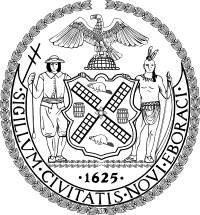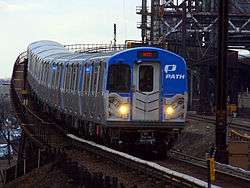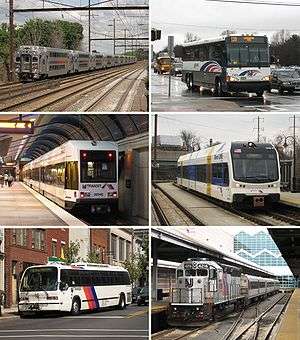Transportation in New York City
The transportation system of New York City is a network of complex infrastructural systems. New York City, being the most populous city in the United States, has a transportation system which includes one of the largest subway systems in the world; the world's first mechanically ventilated vehicular tunnel; and an aerial tramway. New York City is also home to an extensive bus system in each of the five boroughs; citywide and Staten Island ferry systems; and numerous yellow taxis and boro taxis throughout the city. Private cars are less used compared to other cities in the rest of the United States.
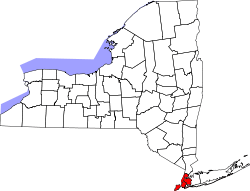 Map of the U.S. state of New York with New York City highlighted in red | |
| Overview | |
|---|---|
| Owner | Metropolitan Transportation Authority, Port Authority of New York and New Jersey, State of New Jersey, other local governments |
| Locale | New York City metropolitan area |
| Transit type | Rapid transit, commuter rail, bus and bus rapid transit, light rail, people mover, aerial tramway, bicycle sharing system, taxicab |
| Daily ridership | More than 10 million |
| Operation | |
| Operator(s) | MTA, NJ Transit, PATH, Port Authority of New York and New Jersey, and private operators |
Within the New York City metropolitan area, the airport system—which includes John F. Kennedy International Airport, LaGuardia Airport, Newark Liberty International Airport (located in New Jersey), Stewart Airport and a few smaller facilities—is one of the largest in the world. The Port of New York and New Jersey, which includes the waterways around New York City and its metropolitan area, is one of the busiest seaports in the United States. There are also three commuter rail systems, the PATH rapid transit system to New Jersey, and various ferries between Manhattan and New Jersey. Numerous separate bus systems also operate to Westchester County, Nassau County, and New Jersey. For private vehicles, a system of expressways and parkways connects New York City with its suburbs.
Background
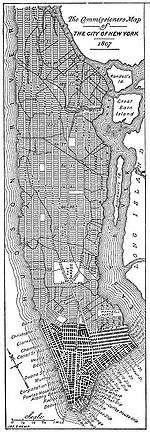
History
The history of New York City's transportation system began with the Dutch port of Nieuw Amsterdam. The port had maintained several roads; some were built atop former Lenape trails, others as "commuter" links to surrounding cities, and one was even paved by 1658 from orders of Petrus Stuyvesant, according to Burrow, et al.[1] The 19th century brought changes to the format of the system's transport: the establishment of a Manhattan street grid through the Commissioners' Plan of 1811,[2] as well as an unprecedented link between the then-separate cities of New York and Brooklyn via the Brooklyn Bridge, in 1883.[3]
The Second Industrial Revolution fundamentally changed the city – the port infrastructure grew at such a rapid pace after the 1825 completion of the Erie Canal that New York became the most important connection between all of Europe and the interior of the United States. Elevated trains and subterranean transportation ('El trains' and 'subways') were introduced between 1867 and 1904. In 1904, the first subway line became operational.[4] Practical private automobiles brought an additional change for the city by around 1930, notably 1927 Holland Tunnel. With automobiles gaining importance, the later rise of Robert Moses was essential to creating New York's modern road infrastructure. Moses was the architect of all 416 miles (669 km) of the parkway, many other important roads, and seven great bridges.[5]
Mass transit use and car ownership
.png)
New York City is distinguished from other U.S. cities for its low personal automobile ownership and its significant use of public transportation. New York City has, by far, the highest rate of public transportation use of any American city, with 67.2% of workers commuting to work by this means in 2006.[6] About one in every three users of mass transit in the United States and two-thirds of the nation's rail riders live in New York City or its suburbs.[7] However, New York City also has the longest mean travel time for commuters (39 minutes) among major U.S. cities.[6]
New York is the only city in the United States where over half of all households do not own a car (Manhattan's non-ownership is even higher, around 75%; nationally, the rate is 8%).[8] However, absolute figures for car ownership are still high when compared to other cities: in 2019, 55% of households were not car owners, indicating that 45% of households did own a car.[9]
Environmental and social issues
New York City's uniquely high rate of public transit use makes it one of the most energy-efficient cities in the United States. Gasoline consumption in the city today is at the rate of the national average in the 1920s.[10] New York City's high rate of transit use saved 1.8 billion US gallons (6,800,000 m3) of oil in 2006 and $4.6 billion in gasoline costs. New York saves half of all the oil saved by transit nationwide.
The reduction in oil consumption meant 11.8 million metric tons of carbon dioxide was kept out of the air.[11] The New York City metro area was ranked by the Brookings Institution as the U.S. metro area with the lowest per-capita transportation-related carbon footprint and as the fourth lowest overall per-capita carbon footprint in 2005 among the 100 largest metro areas of the United States, outranked only by Honolulu, Los Angeles and Portland.[12]
The city's transportation system, and the population density it makes possible, also have other effects. Scientists at Columbia University examined data from 13,102 adults in the city's five boroughs and identified correlations between New York's built environment and public health. New Yorkers residing in densely populated, pedestrian-friendly areas have significantly lower body mass index (BMI) levels compared to other New Yorkers. Three characteristics of the city environment—living in areas with mixed residential and commercial uses, living near bus and subway stops and living in population-dense areas—were found to be inversely associated with BMI levels.[13][14]
Despite the energy efficiency that results from high transit use, the city's streets are generally seen as being dangerous to pedestrians and cyclists. As of 2019, there are on average 225,000 crashes, 61,000 injuries, and 200+ deaths due to automobiles every year in New York City.[15] Approximately 75% of city street space is devoted to moving cars and trucks at speed and parking these vehicles, while the other 25% of the street is left for pedestrians, bikes, and store fronts.[9]
Commuting/modal split
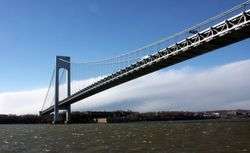
Of all people who commute to work in New York City, 39% use the subway, 23% drive alone, 11% take the bus, 9% walk to work, 7% travel by commuter rail, 4% carpool, 1.6% use a taxi, 1.1% ride their bicycle to work, and 0.4% travel by ferry.[16] 54% of households in New York City do not own a car, and rely on public transportation.[17]
While the so-called car culture dominates in most American cities, mass transit has a defining influence on New York life. The subway is a popular location for politicians to meet voters during elections and is also a major venue for musicians. Each week, more than 100 musicians and ensembles – ranging in genre from classical to Cajun, bluegrass, African, South American and jazz – give over 150 performances sanctioned by New York City Transit, under the Music Under New York program, at a few dozen locations throughout the subway system.[18]
3.7 million people were employed in New York City; Manhattan is the main employment center with 56% of all jobs.[19] Of those working in Manhattan, 30% commute from within Manhattan, while 17% come from Queens, 16% from Brooklyn, 8% from the Bronx, and 2.5% from Staten Island. Another 4.5% commute to Manhattan from Nassau County and 2% from Suffolk County on Long Island, while 4% commute from Westchester County. 5% commute from Bergen and Hudson counties in New Jersey.[19] Some commuters come from Fairfield County in Connecticut. Some New Yorkers reverse commute to the suburbs: 3% travel to Nassau County, 1.5% to Westchester County, 0.7% to Hudson County, 0.6% to Bergen County, 0.5% to Suffolk County, and smaller percentages to other places in the metropolitan area.[19]
On average, New Yorkers spend 1 hour and 27 minutes per weekday commuting with public transit. Of these, 31% ride for more than 2 hours every day. The average amount of time people wait at a stop or station for public transit is 15 minutes, but 23% of riders wait for an average of over 20 minutes. The average distance people usually ride in a single trip with public transit is 9.5 kilometres (5.9 mi).[20]
Ridership
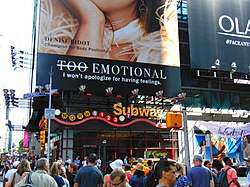
The Metropolitan Transportation Authority (MTA) operates most of New York City's transit systems. Using census data, the MTA reported in August 2006 that ridership on its buses, subways and commuter trains in recent years has grown faster than population growth, indicating that more New Yorkers are choosing to use mass transit, despite the poor service in some areas of New York City by mass transit.[21] The MTA attributed the ridership gains to the introduction of the MetroCard in 1993, and the replacement of more than 2,800 rolling stock since 2000.
From 1995 to 2005, the authority said, ridership on city buses and subways grew by 36%, compared with a population gain in the city of 7%. In the suburbs, it said, a 14% increase in ridership on Metro-North and the Long Island Rail Road outpaced a suburban population gain of 6%.[22] With dramatic increases in fuel prices in 2008, as well as increased tourism and residential growth, ridership on buses and subways grew 3.1% up to about 2.37 billion trips a year compared to 2007. This is the highest ridership since 1965.[23]
In 2013, ridership on the New York City Subway was 1.7 billion,[24] the highest ridership since 1946, despite Hurricane Sandy-related subway closures.[25][26] Ridership in city buses was 803 million.[24][27]
Transit culture

Over 5 million people ride the transit network each weekday, and the system is a major venue for commerce, entertainment, and political activism. Much of the city, excluding Staten Island, relies on the subway, which is open 24 hours a day, as its main source of transportation. Campaigning at subway stations is a staple of New York elections akin to candidate appearances at small town diners during presidential campaigns in the rest of the country. Each week, more than 100 musicians and ensembles – ranging in genre from classical to Cajun, bluegrass, African, South American, and jazz – give over 150 performances sanctioned by New York City Transit at 25 locations throughout the subway system, many under the Music Under New York program.[28] There are many more who are unauthorized performers called buskers, who range from professionals putting on an impromptu show to panhandlers seeking donations by way of performance.
One outcome of the city's extensive mass transit use is a robust local newspaper industry. The readership of many New York dailies consists in large part by transit riders who read during their commutes. The three-day transit strike in December 2005 briefly depressed circulation figures, underscoring the relationship between the city's commuting culture and newspaper readership.[29]
The subways of New York have been venues for beauty pageants and guerrilla theater. The MTA's annual Miss Subways contest ran from 1941 to 1976 and again in 2004 (under the revised name "Ms. Subways").
The subways and commuter rail systems also have some artworks in their stations, commissioned under the MTA Arts & Design umbrella.
Transit systems
Rail
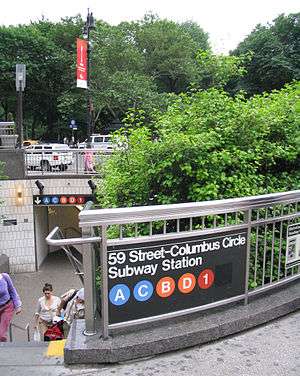
The dominant mode of transportation in New York City is rail. Only 6% of shopping trips in Manhattan's Central Business District involve the use of a car.[30] The city's public transportation network is the most extensive and among the oldest in North America. Responsibility for managing the various components of the system falls to several government agencies. The largest and most important is the Metropolitan Transportation Authority (MTA), a public benefit corporation in the state of New York, which runs two of the city's three rapid transit systems, most of its buses, and two of its three commuter rail networks. Ridership in the city increased 36% to 2.2 billion annual riders from 1995 to 2005, far outpacing population growth.[31][32] Average weekday subway ridership was 5.076 million in September 2006, while combined subway and bus ridership on an average weekday that month was 7.61 million.[33]
Rapid transit systems
MTA
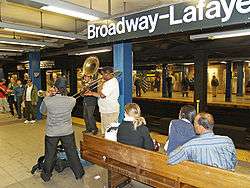
The New York City Subway is the largest subway system in the world when measured by number of stations (472),[34] and the eighth-largest[35] when measured by annual ridership (1.76 billion passenger trips in 2015).[36] It is the second-oldest subway system in the United States after the rapid transit system in Boston. In 2002, an average 4.8 million passengers used the subway each weekday. During one day in September 2005, 7.5 million daily riders set a record for ridership. In 2013, the subway delivered over 1.71 billion rides,[37] averaging approximately 5.5 million rides on weekdays, about 3.2 million rides on Saturdays, and about 2.6 million rides on Sundays. Ridership has been consistently increasing over the last several years, especially because of rising gas prices and the subway's energy efficiency.[38][39][40][41][42] Life in New York City is so dependent on the subway that the city is home to three of only five 24-hour subway systems in the USA.[43] The city's 28 subway services run through all boroughs except Staten Island, which is served 24/7 by the Staten Island Railway.
Subway riders pay with the MetroCard, which is also valid on all other rapid transit systems and buses in the city, as well as the Roosevelt Island tramway. The MetroCard has completely replaced tokens, which were used in the past, to pay fares. Fares are loaded electronically on the card. By 2023, a contactless system called OMNY will replace the MetroCard.
PATH
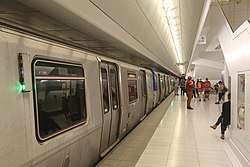
The Port Authority Trans-Hudson (PATH) is a rapid transit system that links Manhattan to Jersey City, Hoboken, Harrison and Newark, in New Jersey. A primary transit link between Manhattan and New Jersey, PATH carries 240,000 passengers each weekday on four lines.[44]
While some PATH stations are adjacent to subway stations in New York City and Newark as well as Hudson-Bergen Light Rail stations in Hudson County, there are no free transfers. The PATH system spans 13.8 miles (22.2 km) of route mileage, not including track overlap. Like the New York City Subway, PATH operates 24 hours a day. Opened in 1908 as the Hudson and Manhattan Railroad, a privately owned corporation, PATH since 1962 has been operated by the Port Authority of New York and New Jersey.
Airport services
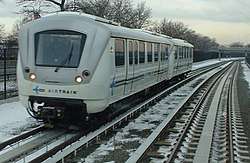
John F. Kennedy and Newark Liberty airports are served by intermodal rail systems. AirTrain JFK is an 8.1 mi (13 km) rapid transit system that connects 24 hours a day Kennedy to New York's subway and commuter rail network in Queens. It also provides free transit between airport terminals. For trips beyond the airport, the train costs $7.75. Roughly 4 million people rode the AirTrain to and from Kennedy in 2006, an increase of about 15% over 2005.[45] AirTrain Newark is a 1.9-mile (3 km) monorail system connecting Newark's three terminals to commuter and intercity trains running on the Northeast Corridor rail line.
Commuter rail
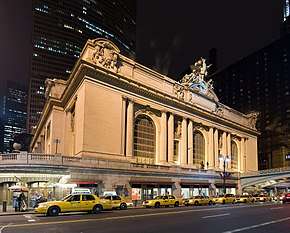
New York City's commuter rail system is the most extensive in the United States, with about 250 stations and 20 rail lines serving more than 150 million commuters annually in the tri-state region.[46] Commuter rail service from the suburbs is operated by two agencies. The MTA operates the Long Island Rail Road on Long Island and the Metro-North Railroad in the Hudson Valley and Connecticut. New Jersey Transit operates the rail network west of the Hudson River. These rail systems converge at the two busiest train stations in the United States, Penn Station and Grand Central Terminal, both in Manhattan.
In addition, connections are available to nearby commuter rail systems: Southeast Connecticut's Shore Line East in New Haven, and Southeast Pennsylvania's SEPTA in Trenton, New Jersey. Service is being considered to Northeast Pennsylvania as far as Scranton, Pennsylvania via the Lackawanna Cut-Off.
Intercity rail
While rail freight transportation in New York City and Long Island has atrophied (most freight activity takes place in northern New Jersey), the city has more frequent passenger rail service (intercity and commuter) than anywhere else in the nation. Intercity service is provided by Amtrak. Fifty-four trains run each day on the busiest route—the Northeast Corridor from New York to Philadelphia. For trips of less than 500 miles (800 km) to other Northeastern cities, Amtrak is often cheaper and faster than air travel. Amtrak accounts for 47% of all non-automobile intercity trips between New York and Washington, D.C. and about 14% of all intercity trips (including those by automobile) between those cities.[47] Amtrak's high-speed Acela trains run from New York to Boston and Washington, D.C., via the Northeast Corridor, using tilting technology and fast electric locomotives. New York City's Penn Station is the busiest Amtrak station in the United States by annual boardings. In 2004 it saw 4.4 million passenger boardings, more than double the next busiest station, Union Station in Washington, D.C.[48]
Overnight trains connect New York City with Chicago (where numerous connections are available to the west coast services), Atlanta, New Orleans, and Miami. There are two daily trains to Miami, one daily train to Charlotte, and one daily train to Savannah. Chicago is connected with New York City by two trains: one runs daily via Upstate New York and Cleveland, while another runs three times a week on a longer route via Cincinnati. Major destinations with frequent service include Albany, Baltimore, Boston, Harrisburg, Philadelphia, Providence, and Washington, D.C. There are also international daily trains to Toronto and Montreal in Canada, via the Empire Corridor to Albany and points west.
Buses
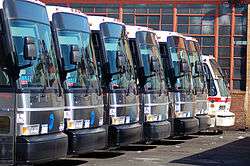
As of 2014, over 5,710 MTA Regional Bus Operations-operated buses carried about 2.5 million daily passengers 24/7 on more than 238 local routes, 62 express routes, and 7 Select Bus Service routes, amounting to 793 million annual bus trips.[49] Buses owned by MTA account for 80% of the city's surface mass transit.[7] New York City has the largest clean-air diesel-hybrid and compressed natural gas bus fleet in the United States.[49] Local bus routes are labeled with a number and a prefix identifying the primary borough (B for Brooklyn, Bx for the Bronx, M for Manhattan, Q for Queens, and S for Staten Island). Express bus routes operated under MTA New York City Bus use the letter X rather than a borough label. Express bus routes operated under MTA Bus (formerly controlled by the NYC Department of Transportation) use a two-borough system with an M at the end (i.e., BM, BxM, SIM, or QM). Additionally, MTA offers precise bus arrival time using QR code located at each stop. Some stops also have digital panels indicating arrival times.
New York Waterway operates connecting bus routes to/from the West Midtown Ferry Terminal and East 34th Street Ferry Landing.
Private bus companies Hampton Jitney and Hampton Luxury Liner operate daily, year-round service from points on the east side of Manhattan to the villages and hamlets of Long Island's east end, including the Hamptons, Montauk, and the North Fork. Hampton Jitney also runs limited service to and from Lower Manhattan and Brooklyn.
Several Chinatown bus lines, which began operating in 1997, offer curbside intercity coach service, mainly to Chinatown and Midtown Manhattan.[50] Two discount intercity bus services, BoltBus and Megabus,[51] have provided bus service between New York City and several other U.S. cities since 2008.[52] In addition, Tripper Bus and Vamoose Bus provide bus service between New York City and the Washington, D.C. suburbs of Arlington, Virginia, and Bethesda, Maryland.[53] BestBus provides daily service from a stop along West 34th Street near 9th Avenue to Washington, D.C., Silver Spring, Maryland, and Manassas, Vienna, and Springfield in Virginia and summer weekend service to Rehoboth Beach and Dewey Beach in Delaware.[54]
Other transit
Other transit in the city includes:
- The Roosevelt Island Tramway, an aerial commuter tram connecting Manhattan to Roosevelt Island. Connecting "Red Bus" service is available on the Island.
- The Bee-Line Bus System, connecting the Bronx and Westchester County.
- Nassau Inter-County Express, a bus system operated by Transdev that connects Queens and Nassau County. Until 2012, it was operated by the MTA under the brand Long Island Bus.
- The Downtown Connection, a free shuttle bus service in Lower Manhattan operated by the Downtown Alliance.
- Private Transportation operates a bus route (labeled B110) between Borough Park and Williamsburg in Brooklyn.
- Dollar vans operate in the boroughs outside Manhattan and in New Jersey.
Major transit hubs
There are several major transit terminals in the New York metropolitan area. They include train stations, bus terminals, and ferry landings.
Major rail stations include:
- New York Penn Station, which is served by Amtrak, Long Island Rail Road, New Jersey Transit, and the New York City Subway
- Grand Central Terminal, which is served by Metro-North Railroad and the New York City Subway
- Jamaica Station, which is served by Long Island Rail Road, New York City Subway, and AirTrain JFK
- Atlantic Terminal, which is served by the New York City Subway and Long Island Rail Road
- Newark Penn Station, which is served by Amtrak, New Jersey Transit, PATH and Newark Light Rail
- Hoboken Terminal, which is served by New Jersey Transit, Metro-North Railroad, PATH, Hudson-Bergen Light Rail, and NY Waterway
Major bus hubs include:
- Port Authority Bus Terminal, served by commuter and intercity buses. The busiest bus station in the United States,[55] the terminal serves both commuter routes, mainly operated by New Jersey Transit, and national routes operated by private companies, such as Greyhound and Peter Pan.[56]
- George Washington Bridge Bus Station, also served by commuter and some intercity buses. Most commuter buses are from New Jersey and Rockland County.
- Penn Station is used by BoltBus, Megabus, Tripper Bus and Vamoose Bus.
- Chinatown, including the corner of East Broadway and Forsyth Street, where several intercity Chinatown buses have a common terminus.
Ferries
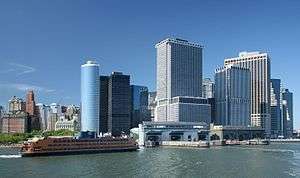
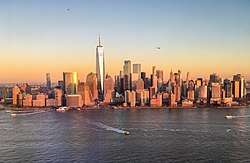
The busiest ferry in the United States is the Staten Island Ferry, which annually carries over 19 million passengers on the 5.2 mile (8.4 km) run between St. George Ferry Terminal and South Ferry. Service is provided 24 hours a day, 365 days a year, and takes approximately 25 minutes each way. Each day eight boats transport almost 65,000 passengers during 104 boat trips. Over 33,000 trips are made annually.[57] The Ferry has remained free of charge since 1997. Vehicles have not been allowed on the Ferry since the September 11, 2001 terrorist attacks, though bicycles are permitted on the lower level at no cost. The ferry ride is a favorite of tourists as it provides excellent views of the Lower Manhattan skyline and the Statue of Liberty.
Since the 1980s ferry service on the Hudson River and East River has been restored and significantly expanded providing regular service to points in Manhattan, mostly below 42nd Street. Pier 11 at Wall Street, East 34th Street Ferry Landing, West Midtown Ferry Terminal and Battery Park City Ferry Terminal are major embarkation points. The terminals are run in public-private partnership with privately owned carriers.
In February 2015, Mayor Bill de Blasio announced that the city government would begin NYC Ferry to extend ferry transportation to traditionally underserved communities in the city.[58][59] The first routes of NYC Ferry opened in 2017.[60][61] All of the system's routes have termini in Manhattan, with routes reaching to Brooklyn, Queens, and the Bronx, as well as a future Staten Island route.[62]
Under the NY Waterway logo, routes are run to Hoboken Terminal, Weehawken Port Imperial, Edgewater Landing, and Paulus Hook Ferry Terminal as well as other ferry slips along the west bank of the Hudson in New Jersey. Its East River shuttles between Wall Street and East 34th Street call at four slips in Brooklyn and Queens. It also operates routes to the Raritan Bayshore.
SeaStreak runs to the Raritan Bayshore, supplementing the unaffiliated NY Waterway service. However, from 2012 to 2014, it also ran weekday morning and afternoon/evening service between East 34th Street and Pier 11 in Manhattan and Rockaway Park, Queens, with a stop at Brooklyn Army Terminal. The service began in late 2012 in the wake of massive subway infrastructure damage and service disruptions in Queens and Brooklyn from Hurricane Sandy, and was originally intended only as a temporary transportation alternative until subway service was restored, but it proved to be popular and was extended several times after that. However, it was ultimately discontinued in October 2014, despite vigorous efforts by local transportation advocates, civic leaders and elected officials to convince the city government to continue funding the subsidized service.[63]
New York Water Taxi makes an East River crossing to Red Hook. Liberty Water Taxi travels between BPC Ferry Terminal and Liberty State Park in Jersey City stopping at Paulus Hook. The companies also run seasonal excursions, notably to the Yankee Stadium and Gateway National Recreation Area beaches.
Additionally, there is year-round ferry service to Ellis Island and Liberty Island[64] and seasonal service to Governor's Island.[65][66] Circle Line Downtown[67] and Circle Line Sightseeing[68] operate tourist routes into the Upper New York Bay or circumnavigate Manhattan.
Ferry landings include:
- East 34th Street Ferry Landing, served by NY Waterway and SeaStreak
- South Street Seaport, served by New York Water Taxi
- St. George Ferry Terminal, served by the Staten Island Ferry
- Pier 11/Wall Street, served by New York Water Taxi, NY Waterway, and SeaStreak
- West Midtown Ferry Terminal, served NY Waterway
- Whitehall Terminal (South Ferry), served by the Staten Island Ferry
- Battery Park City Ferry Terminal, near the World Financial Center, served by NY Waterway, Liberty Water Taxi, New York Water Taxi
- Fulton Slip
- Red Hook
Roads and expressways
Despite New York's reliance on public transit, roads are a defining feature of the city. Manhattan's street grid plan greatly influenced the city's physical development. Several of the city's streets and avenues, like Broadway, Wall Street and Madison Avenue are also used as shorthand or metonym in American vernacular for national industries located there: theater, finance, and advertising, respectively.
In Manhattan, there are twelve numbered avenues that run parallel to the Hudson River, and 220 numbered streets that run perpendicular to the river.
An advanced convergence indexing road traffic monitoring system was installed in New York City for testing purposes in May 2008.
To keep roadways, tunnels, and bridges safe for pedestrians and drivers, New York City has made efficient use of timers to regulate traffic lighting and help conserve energy.
Bridges and tunnels

With its Gothic-revival double-arched stone towers and diagonal suspension wires, the Brooklyn Bridge is one of the city's most recognized architectural structures, depicted by artists such as Hart Crane and Georgia O'Keeffe. The Brooklyn Bridge's main span is 1,596 feet 6 inches (486.61 m), and was the longest in the world when it was completed. The Williamsburg Bridge and Manhattan Bridge are the two others in the trio of architecturally notable East River crossings. The Ed Koch Queensboro Bridge, which links Manhattan and Queens, is an important piece of cantilever bridge design. The borough of Staten Island is connected to Brooklyn through the Verrazano-Narrows Bridge. The George Washington Bridge, spanning the Hudson River between New York City and Fort Lee, New Jersey, is the world's busiest bridge in terms of vehicular traffic.[69][70]
New York has historically been a pioneer in tunnel construction. Most carry rail lines, but there are four exceptions. The Lincoln Tunnel, which carries 120,000 vehicles per day under the Hudson River between New Jersey and Manhattan, is the world's busiest vehicular tunnel. The Holland Tunnel, also under the Hudson River, was the first mechanically ventilated vehicular tunnel in the world and is considered a National Civil Engineering Landmark by the American Society of Civil Engineers. Two other notable tunnels connect Manhattan to other places; one is the Queens Midtown Tunnel, and the other is the Hugh L. Carey Tunnel. At 9,117 feet (2,779 m), the Hugh L. Carey Tunnel (formerly the Brooklyn-Battery Tunnel) is the longest underwater tunnel in North America.
Expressways
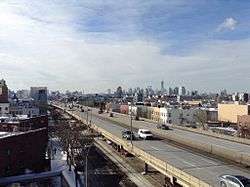
A less favored alternative to commuting by rail and boat is the New York region's expressway network, designed by Robert Moses. The city's extensive network of expressways includes four primary Interstate Highways: Interstate 78, Interstate 80, Interstate 87 and Interstate 95. Interstate 78 and Interstate 87, which have, respectively, their eastern and southern termini in the city, as well as Interstate 95 enter the city limits, while Interstate 80's eastern terminus is in Teaneck, New Jersey. I-278 and I-287 each serve as a partial beltway around the city; Interstate 278 in Staten Island, Brooklyn, Queens, and the Bronx, and Interstate 287 in Westchester County, Rockland County, and Northern New Jersey. I-495 begins at the Queens Midtown Tunnel as the Queens-Midtown Expressway, becomes the Horace Harding Expressway between Queens Blvd and the Nassau County limits and finally becomes the Long Island Expressway into the Long Island suburbs. The 'LIE' moniker is commonly used by denizens of the city to describe the entire length of highway.
New York's limited-access parkways, another Moses Project, are frequently congested as well, despite being designed from the outset to only carry cars, as opposed to commercial trucks or buses. The FDR Drive (originally known as the East River Drive) and Harlem River Drive are two such routes that run along the eastern edge of Manhattan. The Henry Hudson Parkway, the Bronx River Parkway and the Hutchinson River Parkway link the Bronx to nearby Westchester County and its parkways; the Grand Central Parkway and Belt Parkway provide similar functions for Long Island's parkway system.
Private automobiles
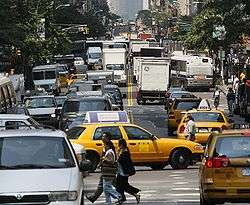
The city's traffic lights are controlled from a Department of Transportation center in Long Island City, with frequent adjustments to alleviate the city's chronic congestion.[71]
Around 48% of New Yorkers own cars, yet fewer than 30% use them to commute to work, most finding public transportation cheaper and more convenient for that purpose, due in large part to traffic congestion which also slows buses. To ease traffic, the Mayor, Michael R. Bloomberg, in 2007 proposed congestion pricing for motor vehicles entering Manhattan's business district from 6:00 a.m. to 6:00 p.m. However, this proposal was defeated when Sheldon Silver, Speaker of the New York State Assembly, announced that the bill would not come up for a vote in his chamber.
The number of gas stations in Manhattan is 40 and falling, causing congestion around them.[72]
Although the rate of electric vehicle ownership in New York City is low compared to the rate of ownership of traditional gas vehicles, there were over 3,000 electric vehicles registered to New York City and Westchester residents between 2011 and 2014, out of almost 300,000 total vehicles registered during this time.[73] There were over 200 public charging stations in New York City,[73] including 105 charging stations in Manhattan, by the end of March 2016.[72] Most charging stations are 208 V or 240 V "Level 2 chargers," but there are also 120 V "Level 1 chargers" in private homes and workplaces; 480 V "DC fast chargers" in some locations; and several Tesla Superchargers around the city, for use only by Tesla, Inc.-manufactured vehicles.[73]
Congestion pricing
Congestion pricing in New York City was a proposed traffic congestion fee for vehicles traveling into or within lower and midtown Manhattan. The congestion pricing charge was one component of Mayor Michael Bloomberg's plan to improve the city's future environmental sustainability while planning for population growth, entitled PlaNYC 2030: A Greener, Greater New York.[74] However, it was not approved as it was never put to a vote on the Assembly.[75]
Delivery trucks
Since the beginning of the 21st century, the growth of e-commerce companies such as Amazon has resulted in an increase in delivery trucks within New York City, with 1.5 million packages being delivered per day by 2019. Several logistics hubs and warehouses have been built within the city to more quickly distribute packages in the New York City area.[76] In 2016, NYCDOT commissioner Polly Trottenberg said that 90% of goods transported into New York City arrived via truck.[77]
The influx of large motor vehicles on the already constricted city streets has had a considerable effect on the flow of traffic. In the most congested areas of Manhattan traffic vehicle traffic moves 23% slower than it has from 2010 to 2019, and for the bridges and tunnels funneling traffic to and from the city, traffic has slowed down even more considerably.[76] As a result, traffic-related pollution increased around 9% from 1990 to 2019, even when adjusted for population growth.[78]
Though it is legal for delivery trucks to double park in most locations while making deliveries during off-peak hours, this often leads to congestion on the surrounding streets when double parking occurs during peak hours.[79] There are often complaints that delivery trucks take up bike lanes and parking spaces. In 2018 alone, four delivery companies (UPS, FedEx, FreshDirect, and Peapod) were fined a combined $27 million due to parking and traffic violations.[76] However, some delivery companies continued to double-park, incorporating any double-parking fines into the delivery fee.[80] Further, the city's Stipulated Parking Fine Program allows drivers to eliminate their previous double-parking violations by paying a predetermined fine without challenging it in court.[81] As a result, in 2019, the NYCDOT started enforcing rules to restrict deliveries in the midtown zone during peak hours, impose a time limit on deliveries, and ban commercial double-parking on streets with one lane of traffic.[80][82] To reduce peak-hour traffic and truck emissions, the NYCDOT also operates the Off-Hour Deliveries Program in Manhattan's midtown zone, which requires deliveries in that zone to be made between 7 pm to 6 am.[83]
Taxis
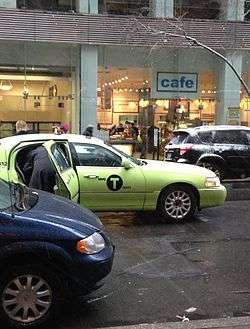
There are 13,237 taxis operating in New York City, not including over 40,000 other for-hire vehicles.[85] Their distinctive yellow paint has made them New York icons.
Taxicabs are operated by private companies and licensed by the New York City Taxi and Limousine Commission. "Medallion taxis", the familiar yellow cabs, are historically the only vehicles in the city permitted to pick up passengers in response to a street hail. In 2013, a new type of street hailed livery vehicles called "boro taxis" in "apple green" color are permitted to pick up passengers in the outer boroughs and the northern part of Manhattan.[84] A cab's availability is indicated by the light on the top of the car. When the light is lit, the cab is empty and available; when it is not lit, the cab is unavailable.
Fares begin at US$3.00 and increase based on the distance traveled and time spent in slow traffic. The passenger also must pay for tolls incurred during the ride.[86] The average cab fare in 2000 was US$6.00; over US$1 billion in fares were paid that year in total.[87]
Since 1999, 241 million passengers have ridden in taxis in New York City. According to the 2000 U.S. Census, of the 42,000 cabbies in New York, 82% are foreign born: 23% from the Caribbean (the Dominican Republic and Haiti), and 20% from South Asia (India, Pakistan, and Bangladesh).[88] Additionally, a large number of American citizen taxi drivers in New York are Puerto Rican or of Puerto Rican descent. In 2014, 23.1% of taxi drivers were from Bangladesh, 13.2% from Pakistan, 9.3% from India, 6.5% from Haiti, 5.9% from the U.S., and 4.4% from Egypt.[89]
In 2005, New York introduced incentives to replace its current yellow cabs with electric hybrid vehicles[90] then in May 2007, New York City Mayor, Michael Bloomberg, proposed a five-year plan to switch New York City's taxicabs to more fuel-efficient hybrid vehicles as part of an agenda for New York City to reduce greenhouse gas emissions as well as surging fuel costs.[91] In 2010, Nissan won a contract to provide the New York with a design based on their NV200 minivan model.
Pedicabs, pedestrians, and bicycles
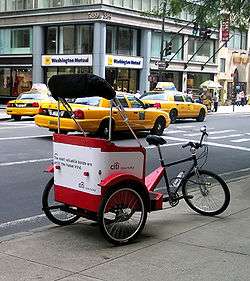
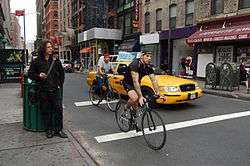
Cycling in New York City is a rapidly growing mode of transport. In 2009, an estimated 200,000 city residents bicycle on a typical day,[92] and make 655,000 trips each day, greater than the number of the ten most popular bus routes in the city.[93]
The city annually hosts the largest recreational cycling event in the United States, the Five Boro Bike Tour, in which 30,000 cyclists ride 42 miles (68 km) through the city's boroughs.
More than 500 people annually work as bicycle rickshaw, or pedicab, drivers, who in 2005 handled one million passengers.[94] The City Council voted twice, including an override of Mayor Bloomberg's veto due to the market cap, in 2007 to license pedicab owners and drivers and allow only 325 pedicab licenses.[95] Neither the limit on pedicabs nor the law itself went into effect due to a successful New York City Pedicab Owners' Association lawsuit over permit issuance.[96] Ultimately, 943 pedicab business owners permits were issued in November 2009 after a second law was passed to address shortcomings of the 2007 law.[97] Today, pedicabs meet market demand in midtown for both ecological transport as well as quick trips within the central business district during afternoon rush hours when motor traffic moves cross town at an average speed of 4.5 miles per hour.
Walk and bicycle modes of travel account for 21% of all modes for trips in the city; nationally the rate for metro regions is about 8%.[98] In 2000 New York had the largest number of walking commuters among large American cities in both total number and as a proportion of all commuters: 517,290, or 5.6%.[99] By way of comparison, the next city with the largest proportion of walking commuters, Boston, had 119,294 commuter pedestrians, amounting to 4.1% of that city's commuters.[99]
Citibank sponsored the introduction of 6,000 public bicycles for the city's bike-share project, Citi Bike, in mid-2013.[100] Research conducted by Quinnipiac University showed that a majority of New Yorkers supported the initiative.[101] Throughout the first year operations, there were more than 100,000 registered members who rode over 14,700,000 miles (23,700,000 km),[102] including 70,000 members in the first three months alone.[103] In 2014, Citi Bike announced that it would expand its operations by 6,000 bikes and add 375 new docking stations by 2017.[104] In November 2018, a further, five-year expansion was announced, which would double the bike-share system's service area to 35 square miles (91 km2). In addition, the number of bicycles would more than triple, from 12,000 to 40,000.[105][106][107] Stalls would be installed in the remainder of Manhattan, as well as parts of Brooklyn, Queens, and the Bronx.[108][109][110]
A "green wave" refers to the programming of traffic lights to allow for continuous traffic flow (a series of green lights) over a number of intersections in one direction. In New York City, this “green wave” prioritizes bikers by timing traffic lights around the average biking speed, in addition to mitigating the negative effects of heavy automotive congestion.[111]After a series of bicyclist deaths in 2019, the highest death toll for cyclists in two decades, the city decided to retime traffic lights, so that vehicles would have to travel an average of 15 miles per hour (24 km/h) between consecutive green lights.[112]
Dollar vans
New York City has many forms of semi-formal and informal public transportation, including "dollar vans", or "jitneys". Dollar vans serve major areas in Brooklyn, Queens and the Bronx that lack adequate subway service. In 2006, the New York City Council began debate on greater industry regulation, including requiring all dollar vans to be painted in a specific color to make them easier to recognize, similar to the public light buses in Hong Kong.[113] The vans pick up and drop off anywhere along a route, and payment is made at the end of a trip.
Similar to dollar vans, Chinese vans serve predominantly Chinese communities in Chinatown; Flushing; Sunset Park; Elmhurst; Bensonhurst and Homecrest.
Jitney buses also provide frequent, essential transportation to parts of Hudson County and Bergen County in New Jersey.[114] Of particular note is the frequent Interstate express service offered along New Jersey Route 4 between the George Washington Bridge Bus Terminal and Paterson, New Jersey, provided by Spanish Transportation.
Highly competitive Chinatown bus lines operate routes from New York City's Chinatowns to other Chinatowns in the Northeast, with frequent service to major cities like Boston, Philadelphia, and Washington, D.C. These companies use full-size coaches and offer fares much lower than traditional carriers like Greyhound and Coach USA, who in turn have gone after the Chinatown carriers by offering online fares as low as $1 on BoltBus, NeOn, and Megabus services.
Aerial tramway
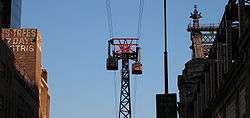
Built in 1976 to shuttle island residents to Midtown, the Roosevelt Island Tramway was originally intended to be a temporary commuter link for use until a subway station was established for the island. However, when the subway finally connected to Roosevelt Island in 1989, the tram was too popular to discontinue use.
The Tramway is operated by the Roosevelt Island Operating Corp (RIOC). Each cable car has a capacity of 125 passengers. Travel time from Roosevelt Island to Manhattan is just under five minutes and the fare is the same as a subway ride.
In 2006, service was suspended on the tramway for six months after a service malfunction that required all passengers to be evacuated.
Airports
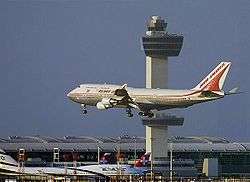
New York City is the top international air passenger gateway to the United States.[115] New York is the busiest air gateway in the nation.[116] In 2011 more than 104 million passengers used the major airports serving the city,[117][118] John F. Kennedy International (also known as JFK), Newark Liberty International, and LaGuardia. Teterboro serves as a primary general aviation airport. JFK and Newark both connect to regional rail systems by a light rail service.[119]
JFK and Newark serve long-haul domestic and international flights. The two airports' outbound international travel accounted for about a quarter of all U.S. travelers who went overseas in 2004.[120] LaGuardia caters to short-haul and domestic destinations.
JFK is the major entry point for international arrivals in the United States and is the largest international air freight gateway in the nation by value of shipments.[121] About 100 airlines from more than 50 countries operate direct flights to JFK. The JFK-London Heathrow route is the leading U.S. international airport pair.[122] The airport is located along Jamaica Bay near Howard Beach, Queens, about 12 miles (19 km) east of downtown Manhattan.
Newark was the first major airport serving New York City and is the fifth busiest international air gateway to the United States.[115] Amelia Earhart dedicated the Newark Airport Administration Building in 1935, which was North America's first commercial airline terminal. In 2003, Newark became the terminus of the world's longest non-stop scheduled airline route, Continental's service to Hong Kong. In 2004, Singapore Airlines broke Continental's record by starting direct 18-hour flights from Newark to Singapore. The airport is located in Newark, New Jersey, about 12 miles (19 km) west of downtown Manhattan.
LaGuardia, the smallest of New York's primary airports, handles domestic flights. It is named for Fiorello H. LaGuardia, the city's great Depression-era mayor known as a reformist and strong supporter of the New Deal. A perimeter rule prohibits incoming and outgoing flights that exceed 1,500 miles (2,400 km) except on Saturdays, when the ban is lifted, and to Denver, which has a grandfathered exemption. As a result, most transcontinental and international flights use JFK and Newark.[123] The airport is located in northern Queens about 6 miles (9.7 km) from downtown Manhattan. Plans were announced in July 2015 to entirely rebuild LaGuardia Airport in a multibillion-dollar project to replace its aging facilities.[124]
Manhattan has three public heliports, used mostly by business travelers. A regularly scheduled helicopter service operates flights to JFK Airport from the Downtown Manhattan Heliport, located at the eastern end of Wall Street. There are also the East 34th Street Heliport and the West 30th Street Heliport
Seaport
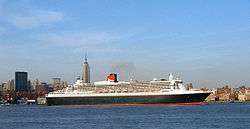
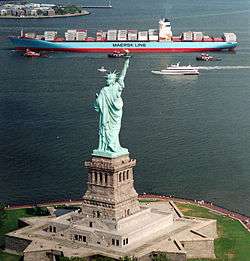
The Port of New York and New Jersey, with its natural advantages of deep water channels and protection from the Atlantic Ocean, has historically been one of the most important ports in the United States, and is now the third busiest in the United States behind South Louisiana and Houston, Texas in volume of cargo. In 2011, more than 34 million tons of oceanborne general cargo moved through the port. Bulk cargo represented another 52 million tons per year. Some 367,000 vehicles were imported and 284,000 were exported.[125] In 2005 more than 5,300 ships delivered to the port goods that went to 35% of the U.S. population.[126] The port is experiencing rapid growth. Shipments increased 5.2% in 2011. There are three cargo terminals on the New York City side of the harbor, including the Howland Hook Marine Terminal on Staten Island, and the combined Red Hook Container Terminal/Brooklyn Marine Terminal. Several additional larger cargo terminals and a passenger terminal are on the New Jersey side.
Originally focused on Brooklyn's waterfront, especially at the Brooklyn Army Terminal in Sunset Park, most container ship cargo operations have shifted to the Port Newark-Elizabeth Marine Terminal on Newark Bay. The terminal, operated by the Port Authority of New York and New Jersey, is the largest port complex on the East Coast, with 4.3 million TEUs (twenty-foot equivalent units) of containerized cargo, which accounts for 61% of the North Atlantic container market. $208 billion of cargo passed through the Port of New York and New Jersey in 2011. The top five trading partners at the port are China, India, Italy, Germany, and Brazil.[125]
The New York Harbor is also a major hub for passenger ships. More than half a million people depart annually from Manhattan's New York Passenger Ship Terminal on the Hudson River, accounting for five percent of the worldwide cruise industry and employing 21,000 residents in the city. The Queen Mary 2, the world's second largest passenger ship and one of the few traditional ocean liners still in service, was designed specifically to fit under the Verrazano Bridge, itself the longest suspension bridge in the United States. The Brooklyn Cruise Terminal is her regular port of call for transatlantic runs from Southampton, England. Cape Liberty Cruise Port in Bayonne is the third passenger terminal servicing the city.
Water quality in the New York Harbor improved dramatically in the late 20th century. New Yorkers regularly kayak and sail in the harbor, which has become a major recreational site for the city.
Future and proposed projects
.jpg)
Several proposals for expanding the New York City transit system are in various stages of discussion, planning, or initial funding. Some proposals will compete with others for available funding:
- Moynihan Station would expand Penn Station into the James Farley Post Office building across the street. The first phase was completed in 2017,[127] while a second phase is set to open in 2022.[128][129]
- The Second Avenue Subway, a north–south line first proposed in 1919,[130] will run from 125th Street in East Harlem to Hanover Square in lower Manhattan when completed.[131] The first phase, from 63rd Street to 96th Street opened for passenger service on January 1, 2017.[132][133][134]
- The East Side Access project will route some Long Island Rail Road trains to Grand Central Terminal instead of Penn Station. Since many LIRR commuters work on the east side of Manhattan, many in walking distance of Grand Central, this project will save travel time and reduce congestion at Penn Station and on subway routes connecting it with the east side. It will also greatly expand the hourly capacity of the LIRR system. Completion is scheduled for 2022.[135][136]
- The Penn Station Access project will allow some Metro-North trains on the New Haven Line, and eventually the Hudson Line, to reach Penn Station.[137] The first phase, which involves four new stops for the New Haven Line, has an expected opening of 2023.[138]:53
- The Gateway Project will add a second pair of railroad tracks under the Hudson River, connecting an expanded Penn Station to NJ Transit and Amtrak lines. This project is a successor to a similar one called Access to the Region's Core, which was canceled in October 2010 by New Jersey Governor Chris Christie.[139] The project has been delayed to a lack of funding.[140]
- Although New York City does not have light rail, a few proposals exist:
- There is a proposal to convert 42nd Street into a light rail transit mall that would be closed to all vehicles except emergency vehicles.[141] The original 1988 plan on which it is based included a loop east to Penn Station along 34th Street. Although a truncated 42nd Street light rail line was approved by the City Council in 1994, it stalled due to lack of funding and opposition from local communities worried about increased traffic. Once the city government proposed the 7 Subway Extension/IRT Flushing Line (7 and <7> trains), it lost interest in any light rail on 42nd Street.[142]
- Staten Island light rail proposals have found political support from Senator Charles Schumer and local political and business leaders.[143]
- Brooklyn Historic Railway Association has also proposed a light rail in Red Hook, Brooklyn,[144] but that was judged to be infeasible and is largely made redundant by the Brooklyn Queens Connector.
- The Brooklyn Queens Connector streetcar connecting Astoria, Queens and Sunset Park, Brooklyn was proposed by Mayor Bill de Blasio in February 2016, with construction planned to begin in 2019 and service around 2029.
- John F. Kennedy International Airport is undergoing a US$10.3 billion redevelopment, one of the largest airport reconstruction projects in the world. In recent years, Terminals 1,[145][146] 4,[147][148] 5,[149] and 8[150] have been reconstructed.
- Santiago Calatrava proposed an aerial gondola system, linking Manhattan, Governors Island, and Brooklyn, as part of the city's plans to develop the island.[151]
- As part of a long-term plan to manage New York City's environmental sustainability, Mayor Michael Bloomberg released several proposals to increase mass transit usage and improve overall transportation infrastructure.[152] Apart from support of the above capital projects, these proposals include the implementation of bus rapid transit, the reopening of closed LIRR and Metro-North stations, new ferry routes, better access for cyclists, pedestrians and intermodal transfers, and a congestion pricing zone for Manhattan south of 86th Street.
See also
References
- Burrows; et al. (1999). Gotham. Oxford Press. ISBN 0-19-511634-8.
- Koeppel, Gerard (2015). City on a Grid: How New York Became New York. Boston: Da Capo Press. ISBN 978-0-306-82284-1.
- "Glorification! The Cities Celebrate the Work That Makes Them One". Brooklyn Daily Eagle. May 24, 1883. p. 12. Retrieved June 26, 2019 – via Brooklyn Public Library; newspapers.com

- Fifty Years of Rapid Transit, 1864–1917. Books.google.com. Retrieved January 7, 2015.
- Caro, Robert (1974). The Power Broker: Robert Moses and the Fall of New York. New York: Knopf. ISBN 978-0-394-48076-3. OCLC 834874.
- U.S. Census Bureau, American Community Survey 2006, Table S0802
- Metropolitan Transportation Authority. "The MTA Network". Retrieved July 15, 2016.
- Bureau of Transportation Statistics, U.S. Department of Transportation (2001). "Highlights of the 2001 National Household Travel Survey". Archived from the original on October 2, 2006. Retrieved May 21, 2006.
- Bellafante, Ginia (July 12, 2019). "New York Was Supposedly Getting Better for Cyclists. What Happened?". The New York Times. ISSN 0362-4331. Retrieved November 5, 2019.
- Jervey, Ben (2006). The Big Green Apple. Globe Pequot Press. ISBN 0-7627-3835-9.
- "A Better Way to Go: Meeting America's 21st Century Transportation Challenges with Modern Public Transit" (PDF). U.S. Public Interest Research Group. March 2008. Retrieved April 23, 2008.
- Marilyn A. Brown (May 29, 2008). "Shrinking the Carbon Footprint of Metropolitan America". The Brookings Institution. Retrieved January 7, 2015.
- Andrew Rundle, P.H. (March 2007). "Living Near Shops, Subways connected to Lower BMI in New York City". American Journal of Health Promotion. Archived from the original on February 6, 2012. Retrieved February 17, 2007.
- "Living Near Shops, Subways Linked to Lower BMI in New York City". Emaxhealth.com. Retrieved January 7, 2015.
- Kuntzman, Gersh (July 18, 2019). "Think Cars Will Always Dominate Because 'New York's Not Holland'? Well, Neither Was Holland!". StreetsBlog NYC. Retrieved November 4, 2019.
- "Table B08406. Sex of Workers by Means of Transportation to Work for Workplace Geography – Universe: Workers 16 Years and Over". 2017 American Community Survey. United States Census Bureau. Archived from the original on February 13, 2020. Retrieved March 29, 2020.
- "Table B08201. Household Size by Vehicles Available – Universe: Households". 2009 American Community Survey. United States Census Bureau. Archived from the original on February 11, 2020.
- Metropolitan Transportation Authority (2016). "Music Under New York". Retrieved July 16, 2016.
- "County-To-County Worker Flow Files". Census 2000. United States Census Bureau.
- "New York Public Transportation Statistics". Global Public Transit Index by Moovit. Retrieved June 19, 2017.

- Introduction to BUS RAPID TRANSIT PHASE II
- Lueck, Thomas J. (August 24, 2006). "M.T.A. Ridership Grows Faster Than Population". New York Times. Retrieved February 24, 2010.
- Chan, Sewell (February 20, 2009). "Subway and Bus Ridership Sets Record". New York Times. Retrieved February 24, 2010.
- "mta.info – Facts and Figures".
- "NYC Subway Ridership At 62 Year High, Despite Sandy Disruptions". WNYC. Retrieved March 2, 2015.
- "Facts and Figures: Annual Subway Ridership". Metropolitan Transportation Authority. Retrieved April 19, 2016.
- "Facts and Figures: Annual Bus Ridership". Metropolitan Transportation Authority. Retrieved April 19, 2016.
- Isra, Tessio. "Limo NYC, Limo Service JFK, New York Limousine, Limo NY". www.nycrichlimo.com. New York City Rich Limo. Retrieved February 1, 2017.
- Ivry, Sara (December 26, 2005). "Since Riders Had No Subways, Commuter Papers Struggled, Too". New York Times. Retrieved February 24, 2010.
- Transportation Alternatives (February 2006). "Necessity or Choice? Why People Drive in Manhattan" (PDF). Archived from the original (PDF) on April 3, 2013. Retrieved November 25, 2012.
- Lueck, Thomas J. (August 24, 2006). "M.T.A. Ridership Grows Faster Than Population". The New York Times. Retrieved August 26, 2006.
- "MTA Ridership Takes Express with 31% Surge". New York Post. August 24, 2006. Retrieved May 10, 2015.
- Neuman, William (November 29, 2006). "Manhattan: Record Use for Subways". The New York Times. Retrieved February 18, 2007.
- "The MTA Network – New York City Transit at a Glance". Metropolitan Transportation Authority. Retrieved August 29, 2014.
- "Subways". Metropolitan Transportation Authority (MTA). April 2, 2013. Retrieved April 26, 2015.
- "Introduction to Subway Ridership". Metropolitan Transportation Authority (MTA). Retrieved April 26, 2015.
- "MTA: Subway Ridership At Highest Level Since 1950". NY1. April 10, 2012. Archived from the original on April 14, 2012. Retrieved April 11, 2012.
- "Subway and Bus Ridership Statistics 2013". Metropolitan Transportation Authority (MTA). Archived from the original on April 22, 2012. Retrieved March 9, 2014.
- TRACK RECORD: 1.5B RODE SUBWAY" by Pete Donohue, New York Daily News, February 11, 2006
- Krauss, Clifford (May 10, 2008). "Gas Prices Send Surge of Riders to Mass Transit". The New York Times. Retrieved May 10, 2008.
- "CBC: Subway ops efficient; buses, commuter rail not so much". Second Ave. Sagas. Retrieved January 7, 2015.
- "Fact #67: BTU per Passenger Mile for U.S. Transit in 1995". US Department of Energy. EERE Information Center. www1.eere.energy.gov. September 4, 1998. Retrieved July 7, 2008.
- The New York City Subway and the PATH both operate 24 hours a day.
- American Public Transportation Association. "APTA Ridership Report: Third Quarter 2006" (PDF). Archived from the original (PDF) on June 15, 2007. Retrieved February 18, 2007.
- "Manhattan: Train-to-Plane Use Sets Record". The New York Times. January 17, 2007. Retrieved February 18, 2007.
- Metropolitan Transportation Authority. "About the MTA Long Island Railroad". Archived from the original on February 2, 2007. Retrieved February 18, 2007.
- Congressional Budget Office (September 2003). "The Past and Future of U.S. Passenger Rail Service" (PDF). Archived from the original (PDF) on February 15, 2007. Retrieved February 18, 2007.
- "TABLE 1-8 Top 50 Amtrak Stations by Number of Boardings: Fiscal Year 2004". Transportation Statistics Annual Report 2005. Bureau of Transportation Statistics, U.S. Department of Transportation. November 2005. Retrieved June 11, 2006.
- Metropolitan Transportation Authority. "Facts and Figures". Retrieved May 11, 2015.
- "Approved Intercity Bus Stops Citywide" (PDF). Archived from the original (PDF) on September 26, 2018. Retrieved May 11, 2015.
- Stellin, Susan (August 27, 2012). "City to City, on the Cheap". New York Times. Retrieved May 11, 2015.
- Clark, Jayne (March 6, 2008). "Leave the NYC-D.C. driving to BoltBus". USA Today. Retrieved February 13, 2010.
- "Compare bus lines between DC and NYC – The Washington Post". Washingtonpost.com. Retrieved January 7, 2015.
- "Schedules". BestBus. Retrieved April 12, 2017.
- "Press Release Article – Port Authority of NY & NJ".
- Port Authority of New York and New Jersey. "History of the Port Authority Bus Terminal". Archived from the original on January 27, 2007. Retrieved February 18, 2007.
- New York City Department of Transportation. "Facts about the Ferry". Archived from the original on February 16, 2007. Retrieved February 18, 2007.
- Mcgeehan, Patrick (June 15, 2016). "De Blasio's $325 Million Ferry Push: Rides to 5 Boroughs, at Subway Price". The New York Times. ISSN 0362-4331. Retrieved June 28, 2016.
- "New York City's Ferry Service Set to Launch in 2017". NBC New York. Retrieved May 9, 2016.
- "NYC launches ferry service with Queens, East River routes". NY Daily News. Associated Press. May 1, 2017. Archived from the original on May 1, 2017. Retrieved May 1, 2017.
- Levine, Alexandra S.; Wolfe, Jonathan (May 1, 2017). "New York Today: Our City's New Ferry". The New York Times. ISSN 0362-4331. Retrieved May 1, 2017.
- "Route Map" (PDF). NYC Ferry. 2017. Archived from the original (PDF) on June 28, 2017. Retrieved July 13, 2017.
- "End of ferry leaves Rockaway a 'transportation desert'". New York's PIX11 / WPIX-TV. Retrieved January 7, 2015.
- "Ferry System Map". Nps.gov. Retrieved January 7, 2015.
- "The Trust for Governors Island – Visit the Island – Directions & Ferry Schedule". Govisland.com. Archived from the original on January 15, 2015. Retrieved January 7, 2015.
- "Operating Hours & Seasons". Nps.gov. Retrieved January 7, 2015.
- "New York City Boat Tours – New York Water Taxi – New York Ferry Tours". Circlelinedowntown.com. Archived from the original on January 6, 2015. Retrieved January 7, 2015.
- "Circle Line Sightseeing Cruises – New York City's Famous Boat Tours". Circleline42.com. Archived from the original on November 17, 2017. Retrieved January 7, 2015.
- "Port Authority of New York and New Jersey – George Washington Bridge". The Port Authority of New York & New Jersey. Retrieved September 13, 2013.
- Bod Woodruff; Lana Zak & Stephanie Wash (November 20, 2012). "GW Bridge Painters: Dangerous Job on Top of the World's Busiest Bridge". ABC News. Retrieved September 13, 2013.
- Greenman, Catherine (September 17, 1998). "Choreographing the Dance of Traffic Lights". The New York Times. Retrieved July 21, 2011.
- "Tesla stations in NYC on verge of outnumbering gas stations". New York Post. March 17, 2016. Retrieved August 7, 2016.
- "Electric Vehicle Advisory Committee" (PDF). nyc.gov. New York City Department of Transportation. 2015. Retrieved August 6, 2016.
- "PlaNYC". Nyc.gov. Retrieved January 7, 2015.
- "$8 Traffic Fee for Manhattan Gets Nowhere". Nytimes.com. Retrieved January 7, 2015.
- Haag, Matthew; Hu, Winnie (October 27, 2019). "1.5 Million Packages a Day: The Internet Brings Chaos to N.Y. Streets". The New York Times. ISSN 0362-4331. Retrieved November 5, 2019.
- Fermino, Chelsia Rose Marcius, Jennifer. "Amazon, FreshDirect home delivery trucks are congesting NYC streets, officials say". nydailynews.com. Retrieved November 5, 2019.
- Popovich, Nadja; Lu, Denise (October 10, 2019). "The Most Detailed Map of Auto Emissions in America". The New York Times. ISSN 0362-4331. Retrieved November 5, 2019.
- "The DOT Quandary: Double-Parking Isn't Illegal — Except When It Actually Is". Streetsblog New York City. May 2, 2019. Retrieved November 5, 2019.
- "NYC Plans New Crackdown On Double Parked Vehicles In Quest To Get Traffic Moving". April 26, 2019. Retrieved November 5, 2019.
- "New York City Council wants to end parking ticket break for delivery trucks". ABC7 New York. October 17, 2018. Retrieved November 5, 2019.
- Berger, Paul. "Double-Parking Crackdown in NYC Would Pinch Businesses". WSJ. Retrieved November 5, 2019.
- "NYC DOT - Manhattan Off Hours Delivery Program". www1.nyc.gov. Retrieved November 5, 2019.
- "Guide to understanding the Street Hail Livery (SHL) Service Rules and Requirements – June 2013" (PDF). NYC Taxi & Limousine Commission. Archived from the original (PDF) on September 27, 2018. Retrieved December 20, 2013.
- New York City Taxi and Limousine Commission (March 9, 2006). "The State of the NYC Taxi" (PDF). Retrieved February 18, 2007.
- New York City Taxi and Limousine Commission. "Passenger Information: Rate of Fare". Retrieved June 11, 2006.
- PBS and WNET (August 2001). "Taxi Dreams". Retrieved February 18, 2007.
- "Turning yellow cabs into gold". The Real Deal New York. September 15, 2007. Retrieved January 7, 2015.
- "Taxicab Factbook 2014" (PDF). nyc.gov. Archived from the original (PDF) on October 24, 2018. Retrieved November 14, 2015.
- "Taxi and Limousine Commission Votes Today to Authorize Cleaner, Greener Hybrid-Electric Taxicabs" (Press release). New York City Taxi & Limousine Commission. September 8, 2005. Archived from the original on October 12, 2006. Retrieved February 13, 2010.
- Rivera, Ray (May 23, 2007). "Mayor Plans an All-Hybrid Taxi Fleet". The New York Times. p. B1. Retrieved February 13, 2010.
- Goodman, J. David (May 2010). "After Criticism, a Bit of Backpedaling". New York Times. Retrieved August 26, 2010.
- Schaller, Bruce (July 2006). "Biking It". Gotham Gazette. Retrieved February 18, 2007.
- Zukowski, Gregg (March 6, 2006). "Regulating Rickshaws". Gotham Gazette. Retrieved February 18, 2007.
- Hicks, Jonathan P. (April 24, 2007). "Pedicab Limit Withstands Mayor's Veto". The New York Times. Retrieved February 13, 2010.
- Chan, Sewell (January 17, 2008). "Court Strikes Down Pedicab Licensing Plan". New York Times. Retrieved February 15, 2010.
- Stadler, David (February 2010). "Pedicab Industry Grapples with Rules, Recession and Rain". Gotham Gazette. Retrieved July 21, 2011.
- U.S. Department of Transportation (December 2004). "2001 National Household Travel Survey: Summary of Travel Trends" (PDF). Retrieved February 18, 2007.
- Federal Highway Administration, U.S. Department of Transportation (January 5, 2006). "Journey to Work Trends in the United States and its Major Metropolitan Areas, 1960–2000". Retrieved February 18, 2007. Note that the U.S. Census reports different figures. See List of U.S. cities with most pedestrian commuters
- James Hamblin (June 28, 2013). "The Summer Bicycles Took Control". The Atlantic Monthly. The Atlantic Monthly Group. Retrieved June 28, 2013.
- Pat Smith; Maurice Carroll (June 27, 2013). "NEW YORK CITY VOTERS BACK MAYOR'S STORM PLAN 4-1, QUINNIPIAC UNIVERSITY POLL FINDS; SLIM MAJORITY BACKS FOOD RECYCLING, BIKE RENTALS" (PDF). Quinnipiac University Poll. Quinnipiac University. Retrieved June 28, 2013.
- Chaban, Matt A.V. (October 28, 2014). "New Leader Will Drive Expansion of Citi Bike". The New York Times. ISSN 0362-4331. Retrieved November 3, 2014.
- Flegenheimer, Matt (August 14, 2013). "The Balancing Act That Bike-Share Riders Just Watch". The New York Times. ISSN 0362-4331. Retrieved February 14, 2017.
- "NYC DOT, Alta and Citi Announce Agreement to Expand and Enhance Citi Bike Program in New York City". New York City Department of Transportation. October 28, 2014. Archived from the original on November 3, 2014. Retrieved November 3, 2014.
- Tieu, Van (November 30, 2018). "Citi Bike is Planning to Triple the Number of its Bikes in NYC". Spectrum News NY1 | New York City. Retrieved November 30, 2018.
- Plitt, Amy (November 29, 2018). "Citi Bike will dramatically expand its NYC footprint". Curbed NY. Retrieved November 30, 2018.
- "Lyft Expands Citi Bike in NYC, and Uber Is None too Happy". WIRED. November 29, 2018. Retrieved November 30, 2018.
- Fitzsimmons, Emma G.; Randle, Aaron (July 16, 2019). "6 Years Later, Citi Bike Comes to the Bronx. (What Took So Long?)". The New York Times. ISSN 0362-4331. Retrieved July 17, 2019.
- "Citi Bike expanding into the Bronx, will double service area by 2023". ABC7 New York. July 16, 2019. Retrieved July 17, 2019.
- "Citi Bike To Double In Size (By 2023)". Gothamist. July 16, 2019. Archived from the original on July 17, 2019. Retrieved July 17, 2019.
- https://www1.nyc.gov/office-of-the-mayor/news/368-19/vision-zero-mayor-de-blasio-green-wave-bicycle-plan-address-cycling-fatalities---/#/0. “Vision Zero: Mayor de Blasio Announces ‘Green Wave’ Bicycle Plan to Address Cycling Fatalities—With Citywide Protected Bike Lane Network and Increased Enforcement”. The Official Website of the City of New York. July 25, 2019.
- Hu, Winnie (October 23, 2019). "After Cyclist Deaths, City Adjusts Traffic Lights to Slow Cars". The New York Times. ISSN 0362-4331. Retrieved November 4, 2019.
- Lueck, Thomas J. (April 30, 2006). "New Yorkers May Soon Be Able to Tell A Van, as They Do a Cab, by Its Color". The New York Times. Archived from the original on November 2, 2012. Retrieved February 18, 2007.
- "Jitney minibuses offer a cheaper option for N.J. passengers, but ride can be risky". Star-Ledger. July 11, 2010.
- "Table 10: Top 20 U.S. Gateways for Nonstop International Air Travel: 1990, 1995, and 2000". U.S. International Travel and Transportation Trends, BTS02-03. Bureau of Transportation Statistics, U.S. Department of Transportation. 2002. Archived from the original on October 2, 2006. Retrieved February 18, 2007.
- The Port Authority of New York and New Jersey (November 2, 2006). "2005 Annual Airport Traffic Report" (PDF). Archived from the original (PDF) on June 5, 2007. Retrieved February 18, 2007.
- Non Stop Service (PDF) (Report). PANYNJ. 2011. Archived from the original (PDF) on July 27, 2014. Retrieved January 13, 2013.
- Air Traffic Report 2011 (PDF) (Report). PANYNJ. Retrieved January 4, 2013.
- See AirTrain JFK and AirTrain Newark.
- The Port Authority of New York and New Jersey (August 29, 2005). "Port Authority Leads Nation in Record-Setting Year for Travel Abroad". Archived from the original on October 2, 2006. Retrieved February 18, 2007.
- Bureau of Transportation Statistics, U.S. Department of Transportation (2004). "America's Freight Transportation Gateways" (PDF). Archived from the original (PDF) on September 27, 2006. Retrieved February 18, 2007.
- Bureau of Transportation Statistics, U.S. Department of Transportation (2002). "U.S. International Travel and Transportation Trends, BTS02-03" (PDF). Archived from the original (PDF) on October 2, 2006. Retrieved February 18, 2007.
- "Long Distance at La Guardia". The New York Sun. August 5, 2005. Retrieved February 18, 2007.
- Patrick McGeehan (July 27, 2015). "La Guardia Airport to Be Overhauled by 2021, Cuomo and Biden Say". The New York Times. Retrieved July 28, 2015.
- "2011 trade statistics" (PDF). Panynj.gov. Retrieved January 7, 2015.
- Berkey-Gerard, Mark; Arnow, Pat (March 2003). "New York's Port, Beyond Dubai". Gotham Gazette. Retrieved February 19, 2007.
- Warerkar, Tanay (June 15, 2017). "Penn Station's West End Concourse finally opens to the public". Curbed NY. Retrieved June 23, 2017.
- "More space, accessibility part of $600 million Penn Station makeover". am New York. March 15, 2019. Retrieved March 18, 2019.
- "news – Governor Cuomo Announces New Main Entrance to Penn Station and Expansion of LIRR Concourse". MTA. September 6, 2018. Retrieved September 7, 2018.
- "CITY'S GROWTH DISCOUNTED IN PLANS FOR ADDING 830 MILES OF TRACK TO RAPID TRANSIT SYSTEMS; Work to Cover Period of Twenty-five Years and Cost $350,000,000--New Lines and Extensions Would Provide for a Population of Nine Millions and Carry Five Billion Passengers" (PDF). The New York Times. October 3, 1920. ISSN 0362-4331. Retrieved January 2, 2017.
- "MTA Capital Construction – Second Avenue Subway Project Description". mta.info. Metropolitan Transportation Authority. Archived from the original on April 8, 2014. Retrieved October 5, 2013.
- Slotnik, Daniel E.; Wolfe, Jonathan; Fitzsimmons, Emma G.; Palmer, Emily; Remnick, Noah (January 1, 2017). "Opening of Second Avenue Subway: Updates". The New York Times. ISSN 0362-4331. Retrieved January 1, 2017.
- Rivoli, Dan; Sandoval, Edgar; Brown, Stephen Rex (January 1, 2017). "New Yorkers take historic first ride on Second Ave. subway". New York Daily News. Retrieved January 1, 2017.
- Nessen, Stephen (January 1, 2017). "See Inside: The 2nd Avenue Subway Opens to All". WNYC. Retrieved January 1, 2017.
- Siff, Andrew (April 16, 2018). "MTA Megaproject to Cost Almost $1B More Than Prior Estimate". NBC New York. Retrieved April 16, 2018.
- Castillo, Alfonso A. (April 15, 2018). "East Side Access price tag now stands at $11.2B". Newsday. Retrieved April 16, 2018.
- "Penn Station Access Proposed "Build" Alternative" (PDF). mta.info. Metropolitan Transportation Authority. Retrieved February 17, 2016.
- "Capital Program Oversight Committee Meeting" (PDF). Metropolitan Transportation Authority. April 2019. Retrieved January 18, 2019.
- Frassinelli, Mike (February 6, 2011). "N.J. senators, Amtrak official to announce new commuter train tunnel project across the Hudson". The Star-Ledger. Retrieved February 7, 2011.
- "N.Y., N.J. Lawmakers Scramble For Backup Plan After Trump 2020 Budget Cuts Money From Gateway Project Fund". CBS New York. March 12, 2019. Retrieved June 24, 2019.
- "Home page". vision42. The Institute for Rational Urban Mobility, Inc. 2000–2013. Archived from the original on January 21, 2013. Retrieved October 8, 2013.
- "America's Invisible Trolley System". Newsweek.com. Retrieved January 7, 2015.
- "Reality check for Staten Island's rail plans". SILive.com. Retrieved January 7, 2015.
- Kimmelman, Michael (April 20, 2014). "Brooklyn to Queens, but Not by Subway: Imagining a Streetcar Line Along the Waterfront". The New York Times.
- "Aviation Projects". William Nicholas Bodouva and Associates. Retrieved June 13, 2012.
- "Terminal One Group website". Jfkterminalone.com. Archived from the original on February 24, 2012. Retrieved June 2, 2012.
- Cooper, Peter (November 24, 2010). "John F. Kennedy Airport in New York Commences Terminal 4 Expansion Project". WIDN News. Archived from the original on November 28, 2010. Retrieved November 24, 2010.
- "Delta opens new JFK Terminal 4 hub". Queens Chronicle. Retrieved May 31, 2013.
- "New Hawaiian – JetBlue Partnership Brings Hawaii Closer to East Coast Cities" (Press release). JetBlue Airways. January 23, 2012. Archived from the original on January 27, 2013. Retrieved July 7, 2012.
- "LAN Airlines Moves Into Terminal 8 at JFK With American Airlines" (Press release). American Airlines. January 31, 2012. Retrieved July 7, 2012.
- Josh Rogers (February 17–23, 2006). "That's 125 million dollars, not lira for this island gondola". Downtown Express. Retrieved October 8, 2013.
- Archived October 23, 2007, at the Wayback Machine
Further reading
- Ascher, Kate, The Works: Anatomy of a City, 2005
- Cheape, Charles W., Moving the masses: urban public transit in New York, Boston, and Philadelphia, 1880–1912, Harvard University Press, 1980. ISBN 0-674-58827-4
- Mathew, Biju, Taxi!: Cabs and Capitalism in New York City, 2005
- Solis, Julia, New York Underground, 2004
- Tanenbaum, Susie J., Underground Harmonies: Music and Politics in the Subways of New York , 1995
External links
| Wikimedia Commons has media related to Transport in New York City. |
- MTA official website
- PANYNJ official website
- NYC area transit map
- Regional Plan Association
- New York Metropolitan Transportation Council, an association of urban and suburban agencies
